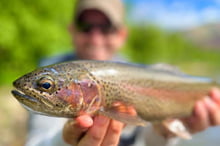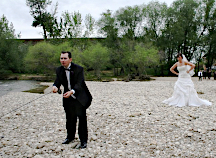No products in the cart.
Low Flow

A Fly Fisherman’s Treat
Story and Photos by Erik Moncada
When the South Fork of the Boise River was running at a very low three hundred cubic feet per second during fishing season last July, it was a treat I couldn’t miss. It also would be my first opportunity to really test my new tippet on some mean trout. For the uninitiated, the tippet is the end section of line on a fly rig, very thin and lightweight, to avoid disturbing the fish. I had used this tippet on bluegill, but that was hardly a real test of the stuff’s tensile strength.
My brother Kris and I got to the river early, but other diehard anglers already were setting up gear as we drove past them. The lush landscape was a welcome sight. As we arrived at our spot, caddis were flying around, and a few fish were taking them off the surface. A fish rising to a caddis will behave differently. You will easily see the head of the fish fully come out of the water, or the fish can create a splash-rise when feeding. Both these things were happening and with all the caddis on the water, I could choose from a multitude of fly sizes. The largest caddis flying around were size twelve, so that’s what I chose.
I secured it to the tippet and targeted a rising fish.
“First fish of the day!” I yelled out to Kris, who was fishing on the other side of the river.
“Oh, nice!” he yelled back, as the fish put on an Olympics-worthy display of acrobatics.
“Whoa, whoa, fish!” I yelled with every jump.
The fish tired quickly, and I got it to the net fast. It was a beauty, but was it really a test on the tippet? I felt I could do better, and released the fish quickly, because several more were rising.
This content is available for purchase. Please select from available options.
Purchase Only
Purchase Only

